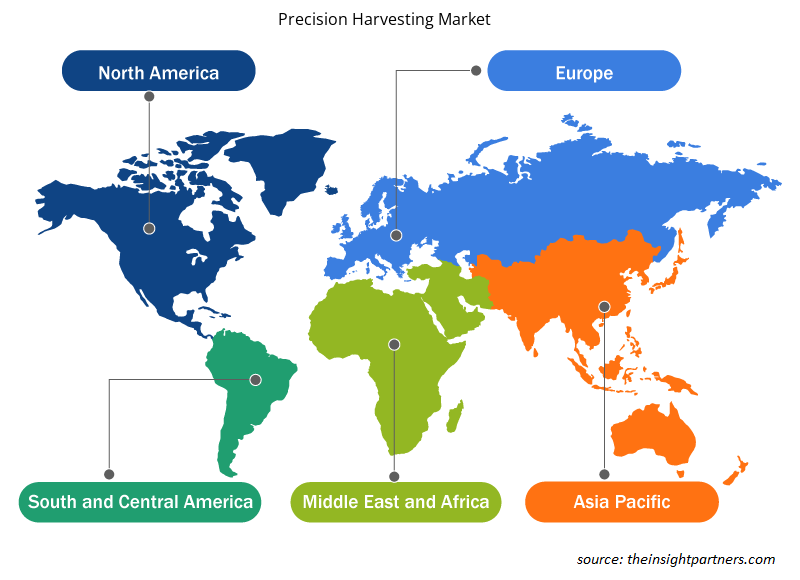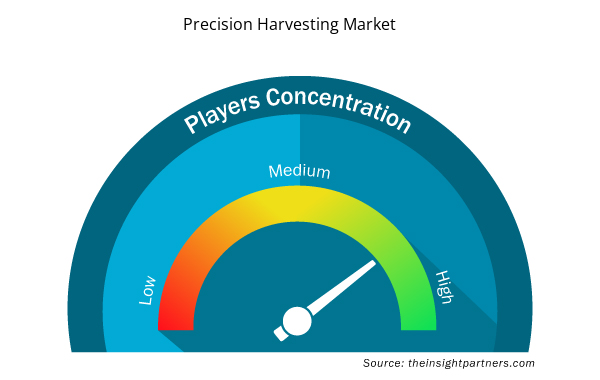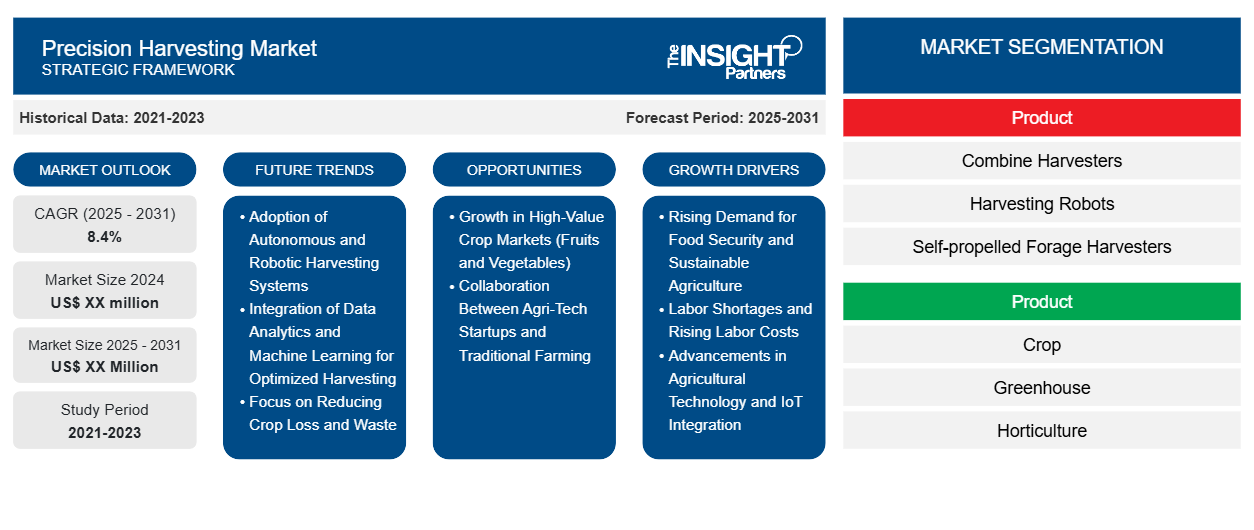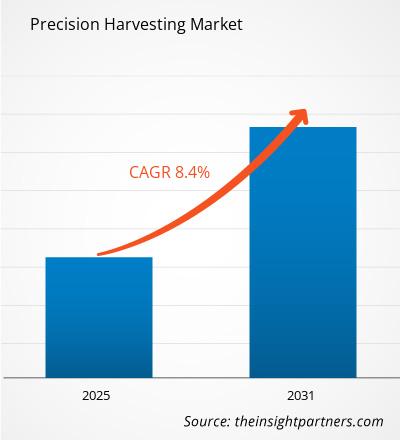Se espera que el mercado de cosecha de precisión registre una CAGR del 8,4 % entre 2024 y 2031, con un tamaño de mercado que se expandirá de US$ XX millones en 2024 a US$ XX millones en 2031.CAGR of 8.4% from 2024 to 2031, with a market size expanding from US$ XX million in 2024 to US$ XX Million by 2031.
El informe está segmentado por producto (cosechadoras, robots de cosecha, cosechadoras de forraje autopropulsadas), producto (cultivo, invernadero, horticultura, otros), oferta (hardware, software, servicios). El análisis global se desglosa aún más a nivel regional y por países principales. El informe ofrece el valor en USD para el análisis y los segmentos anteriores.
Propósito del Informe
El informe Precision Harvesting Market de The Insight Partners tiene como objetivo describir el panorama actual y el crecimiento futuro, los principales factores impulsores, los desafíos y las oportunidades. Esto proporcionará información a diversas partes interesadas del negocio, como:
- Proveedores/fabricantes de tecnología: Para comprender la dinámica cambiante del mercado y conocer las oportunidades potenciales de crecimiento, lo que les permitirá tomar decisiones estratégicas informadas.
- Inversionistas: Realizar un análisis exhaustivo de tendencias sobre la tasa de crecimiento del mercado, las proyecciones financieras del mercado y las oportunidades que existen en toda la cadena de valor.
- Órganos reguladores: Regular las políticas y vigilar las actividades del mercado con el objetivo de minimizar los abusos, preservar la confianza de los inversores y defender la integridad y la estabilidad del mercado.
Segmentación del mercado de cosecha de precisión
Producto
- Cosechadoras
- Robots de cosecha
- Cosechadoras de forraje autopropulsadas
Producto
- Cultivo
- Invernadero
- Horticultura
- Otros
Ofrenda
- Hardware
- Software
- Servicios
Geografía
- América del norte
- Europa
- Asia-Pacífico
- América del Sur y Central
- Oriente Medio y África
Personalice este informe según sus necesidades
Obtendrá personalización en cualquier informe, sin cargo, incluidas partes de este informe o análisis a nivel de país, paquete de datos de Excel, así como también grandes ofertas y descuentos para empresas emergentes y universidades.
- Obtenga las principales tendencias clave del mercado de este informe.Esta muestra GRATUITA incluirá análisis de datos, desde tendencias del mercado hasta estimaciones y pronósticos.
Factores impulsores del crecimiento del mercado de la cosecha de precisión
- Demanda creciente de seguridad alimentaria y agricultura sostenible: el crecimiento de la población mundial y la creciente demanda de alimentos están impulsando la necesidad de prácticas agrícolas más eficientes y sostenibles. Las tecnologías de cosecha de precisión, como los sistemas de cosecha automatizados y los sensores, ayudan a optimizar el rendimiento de los cultivos, reducir los desechos y minimizar el impacto ambiental. Estos avances contribuyen a mejorar la seguridad alimentaria al tiempo que garantizan prácticas agrícolas sostenibles, lo que impulsa la demanda de soluciones de cosecha de precisión.
- Escasez de mano de obra y aumento de los costos laborales: la escasez de mano de obra, en particular en la agricultura, combinada con el aumento de los costos laborales, son los principales impulsores de la adopción de tecnologías de cosecha de precisión. Los sistemas de cosecha automatizados, como las cosechadoras robóticas, pueden reducir la dependencia de la mano de obra humana, al tiempo que aumentan la eficiencia y reducen los costos operativos. A medida que los agricultores buscan formas de abordar los desafíos laborales, los equipos de cosecha de precisión brindan una solución eficaz para reducir la dependencia de la mano de obra y mantener la productividad.
- Avances en la tecnología agrícola y la integración de IoT: la integración de dispositivos de Internet de las cosas (IoT), aprendizaje automático y tecnologías de inteligencia artificial en la agricultura está revolucionando la cosecha de precisión. Estos avances permiten a los agricultores monitorear la salud de los cultivos, las condiciones del suelo y los plazos de cosecha en tiempo real. A medida que la tecnología se vuelve más accesible y rentable, aumenta la adopción de sistemas de cosecha de precisión, lo que permite a los agricultores tomar decisiones basadas en datos y optimizar el proceso de cosecha.
Tendencias futuras del mercado de la cosecha de precisión
- Adopción de sistemas de cosecha autónomos y robóticos: la tendencia hacia la automatización en la agricultura está transformando el mercado de la cosecha de precisión. Los sistemas de cosecha autónomos y robóticos son cada vez más populares por su capacidad de trabajar de manera eficiente y autónoma en los campos. Estos sistemas utilizan sensores avanzados y algoritmos de inteligencia artificial para identificar cultivos maduros, cosecharlos con precisión y operar sin intervención humana. Se espera que esta tendencia continúe a medida que las soluciones robóticas mejoren en funcionalidad, velocidad y rentabilidad.
- Integración de análisis de datos y aprendizaje automático para una cosecha optimizada: el análisis de datos y el aprendizaje automático desempeñan un papel fundamental en el mercado de la cosecha de precisión. Al recopilar y analizar datos de sensores y dispositivos IoT, los agricultores pueden obtener información sobre el mejor momento para la cosecha, el rendimiento óptimo de los cultivos y las posibles áreas de mejora. La integración de algoritmos de aprendizaje automático ayuda a predecir las condiciones de la cosecha y a garantizar que los cultivos se cosechen en el momento ideal, lo que mejora la productividad y reduce los desperdicios.
- Enfoque en la reducción de pérdidas y desperdicios de cultivos: las tecnologías de cosecha de precisión se centran cada vez más en la reducción de pérdidas y desperdicios de cultivos, una tendencia importante en el mercado. Con la ayuda de máquinas avanzadas que pueden cosechar selectivamente solo cultivos maduros y dejar atrás los que no están maduros, se minimiza el desperdicio y se maximiza la productividad. Esto es especialmente importante en cultivos de alto valor como frutas y verduras, donde la sobrecosecha o la subcosecha pueden provocar pérdidas significativas. La tendencia hacia la reducción del desperdicio de alimentos mediante una cosecha precisa se está convirtiendo en un aspecto crítico del mercado.
Oportunidades de mercado en la cosecha de precisión
- Crecimiento en los mercados de cultivos de alto valor (frutas y verduras): la cosecha de precisión presenta una oportunidad prometedora en los mercados de cultivos de alto valor, como las frutas y las verduras. Estos cultivos suelen requerir un manejo más delicado y una cosecha precisa para mantener la calidad. Mediante el uso de tecnologías avanzadas como cosechadoras robóticas y sistemas de clasificación impulsados por IA, los agricultores pueden mejorar el rendimiento y la calidad de estos cultivos y, al mismo tiempo, minimizar el desperdicio. A medida que la demanda de productos frescos sigue creciendo a nivel mundial, la cosecha de precisión desempeñará un papel fundamental para garantizar cosechas óptimas para estos cultivos.
- Colaboración entre las empresas emergentes de tecnología agrícola y la agricultura tradicional: existe una creciente oportunidad de colaboración entre las empresas emergentes de tecnología agrícola innovadoras y las explotaciones agrícolas tradicionales para impulsar la adopción de tecnologías de cosecha de precisión. Las empresas emergentes están desarrollando tecnologías nuevas y asequibles, mientras que las explotaciones agrícolas tradicionales aportan conocimientos agrícolas profundos y acceso al mercado. Al trabajar juntos, ambos pueden acelerar la integración de soluciones de cosecha de precisión, creando un ecosistema agrícola más sostenible y eficiente. Es probable que esta colaboración sea una oportunidad clave para el mercado a medida que crece y madura.
Perspectivas regionales del mercado de cosecha de precisión
Los analistas de Insight Partners explicaron en detalle las tendencias y los factores regionales que influyen en el mercado de la cosecha de precisión durante el período de pronóstico. Esta sección también analiza los segmentos y la geografía del mercado de la cosecha de precisión en América del Norte, Europa, Asia Pacífico, Oriente Medio y África, y América del Sur y Central.

- Obtenga datos regionales específicos para el mercado de cosecha de precisión
Alcance del informe de mercado de cosecha de precisión
| Atributo del informe | Detalles |
|---|---|
| Tamaño del mercado en 2024 | XX millones de dólares estadounidenses |
| Tamaño del mercado en 2031 | US$ XX millones |
| Tasa de crecimiento anual compuesta (CAGR) global (2025-2031) | 8,4% |
| Datos históricos | 2021-2023 |
| Período de pronóstico | 2025-2031 |
| Segmentos cubiertos | Por producto
|
| Regiones y países cubiertos | América del norte
|
| Líderes del mercado y perfiles de empresas clave |
|
Densidad de actores del mercado de cosecha de precisión: comprensión de su impacto en la dinámica empresarial
El mercado de la cosecha de precisión está creciendo rápidamente, impulsado por la creciente demanda de los usuarios finales debido a factores como la evolución de las preferencias de los consumidores, los avances tecnológicos y una mayor conciencia de los beneficios del producto. A medida que aumenta la demanda, las empresas amplían sus ofertas, innovan para satisfacer las necesidades de los consumidores y aprovechan las tendencias emergentes, lo que impulsa aún más el crecimiento del mercado.
La densidad de actores del mercado se refiere a la distribución de las empresas o firmas que operan dentro de un mercado o industria en particular. Indica cuántos competidores (actores del mercado) están presentes en un espacio de mercado determinado en relación con su tamaño o valor total de mercado.
Las principales empresas que operan en el mercado de cosecha de precisión son:
- Tecnología líder en agricultura
- Corporación AGCO
- AgJunción
- CLAAS KGaA mbH
- Deere y compañía
Descargo de responsabilidad : Las empresas enumeradas anteriormente no están clasificadas en ningún orden particular.

- Obtenga una descripción general de los principales actores clave del mercado de cosecha de precisión
Puntos de venta clave
- Cobertura integral: el informe cubre de manera integral el análisis de productos, servicios, tipos y usuarios finales del mercado de cosecha de precisión, proporcionando un panorama holístico.
- Análisis de expertos: el informe se compila sobre la base de un profundo conocimiento de expertos y analistas de la industria.
- Información actualizada: El informe asegura relevancia comercial debido a su cobertura de información reciente y tendencias de datos.
- Opciones de personalización: este informe se puede personalizar para satisfacer los requisitos específicos del cliente y adaptarse adecuadamente a las estrategias comerciales.
Por lo tanto, el informe de investigación sobre el mercado de la cosecha de precisión puede ayudar a abrir camino para descifrar y comprender el escenario de la industria y las perspectivas de crecimiento. Si bien puede haber algunas preocupaciones válidas, los beneficios generales de este informe tienden a superar las desventajas.
- Análisis histórico (2 años), año base, pronóstico (7 años) con CAGR
- Análisis PEST y FODA
- Tamaño del mercado Valor/volumen: global, regional, nacional
- Industria y panorama competitivo
- Conjunto de datos de Excel



Report Coverage
Revenue forecast, Company Analysis, Industry landscape, Growth factors, and Trends

Segment Covered
This text is related
to segments covered.

Regional Scope
North America, Europe, Asia Pacific, Middle East & Africa, South & Central America

Country Scope
This text is related
to country scope.
Preguntas frecuentes
Some of the customization options available based on the request are an additional 3-5 company profiles and country-specific analysis of 3-5 countries of your choice. Customizations are to be requested/discussed before making final order confirmation# as our team would review the same and check the feasibility
The report can be delivered in PDF/PPT format; we can also share excel dataset based on the request
Artificial intelligence and machine learning integration to play a significant role in the global precision harvesting market in the coming years
Increasing agricultural labor costs and growing demand for food security are the major factors driving the precision harvesting market
The Precision Harvesting Market is estimated to witness a CAGR of 8.4% from 2023 to 2031
Trends and growth analysis reports related to Electronics and Semiconductor : READ MORE..
1. Ag Leader Technology
2. AGCO Corporation
3. AgJunction
4. CLAAS KGaA mbH
5. Deere and Company
6. DICKEY-john
7. PELLENC S.A.S
8. Raven Industries, Inc.
9. TEEJET TECHNOLOGIES
10. Trimble Inc.
The Insight Partners performs research in 4 major stages: Data Collection & Secondary Research, Primary Research, Data Analysis and Data Triangulation & Final Review.
- Data Collection and Secondary Research:
As a market research and consulting firm operating from a decade, we have published and advised several client across the globe. First step for any study will start with an assessment of currently available data and insights from existing reports. Further, historical and current market information is collected from Investor Presentations, Annual Reports, SEC Filings, etc., and other information related to company’s performance and market positioning are gathered from Paid Databases (Factiva, Hoovers, and Reuters) and various other publications available in public domain.
Several associations trade associates, technical forums, institutes, societies and organization are accessed to gain technical as well as market related insights through their publications such as research papers, blogs and press releases related to the studies are referred to get cues about the market. Further, white papers, journals, magazines, and other news articles published in last 3 years are scrutinized and analyzed to understand the current market trends.
- Primary Research:
The primarily interview analysis comprise of data obtained from industry participants interview and answers to survey questions gathered by in-house primary team.
For primary research, interviews are conducted with industry experts/CEOs/Marketing Managers/VPs/Subject Matter Experts from both demand and supply side to get a 360-degree view of the market. The primary team conducts several interviews based on the complexity of the markets to understand the various market trends and dynamics which makes research more credible and precise.
A typical research interview fulfils the following functions:
- Provides first-hand information on the market size, market trends, growth trends, competitive landscape, and outlook
- Validates and strengthens in-house secondary research findings
- Develops the analysis team’s expertise and market understanding
Primary research involves email interactions and telephone interviews for each market, category, segment, and sub-segment across geographies. The participants who typically take part in such a process include, but are not limited to:
- Industry participants: VPs, business development managers, market intelligence managers and national sales managers
- Outside experts: Valuation experts, research analysts and key opinion leaders specializing in the electronics and semiconductor industry.
Below is the breakup of our primary respondents by company, designation, and region:

Once we receive the confirmation from primary research sources or primary respondents, we finalize the base year market estimation and forecast the data as per the macroeconomic and microeconomic factors assessed during data collection.
- Data Analysis:
Once data is validated through both secondary as well as primary respondents, we finalize the market estimations by hypothesis formulation and factor analysis at regional and country level.
- Macro-Economic Factor Analysis:
We analyse macroeconomic indicators such the gross domestic product (GDP), increase in the demand for goods and services across industries, technological advancement, regional economic growth, governmental policies, the influence of COVID-19, PEST analysis, and other aspects. This analysis aids in setting benchmarks for various nations/regions and approximating market splits. Additionally, the general trend of the aforementioned components aid in determining the market's development possibilities.
- Country Level Data:
Various factors that are especially aligned to the country are taken into account to determine the market size for a certain area and country, including the presence of vendors, such as headquarters and offices, the country's GDP, demand patterns, and industry growth. To comprehend the market dynamics for the nation, a number of growth variables, inhibitors, application areas, and current market trends are researched. The aforementioned elements aid in determining the country's overall market's growth potential.
- Company Profile:
The “Table of Contents” is formulated by listing and analyzing more than 25 - 30 companies operating in the market ecosystem across geographies. However, we profile only 10 companies as a standard practice in our syndicate reports. These 10 companies comprise leading, emerging, and regional players. Nonetheless, our analysis is not restricted to the 10 listed companies, we also analyze other companies present in the market to develop a holistic view and understand the prevailing trends. The “Company Profiles” section in the report covers key facts, business description, products & services, financial information, SWOT analysis, and key developments. The financial information presented is extracted from the annual reports and official documents of the publicly listed companies. Upon collecting the information for the sections of respective companies, we verify them via various primary sources and then compile the data in respective company profiles. The company level information helps us in deriving the base number as well as in forecasting the market size.
- Developing Base Number:
Aggregation of sales statistics (2020-2022) and macro-economic factor, and other secondary and primary research insights are utilized to arrive at base number and related market shares for 2022. The data gaps are identified in this step and relevant market data is analyzed, collected from paid primary interviews or databases. On finalizing the base year market size, forecasts are developed on the basis of macro-economic, industry and market growth factors and company level analysis.
- Data Triangulation and Final Review:
The market findings and base year market size calculations are validated from supply as well as demand side. Demand side validations are based on macro-economic factor analysis and benchmarks for respective regions and countries. In case of supply side validations, revenues of major companies are estimated (in case not available) based on industry benchmark, approximate number of employees, product portfolio, and primary interviews revenues are gathered. Further revenue from target product/service segment is assessed to avoid overshooting of market statistics. In case of heavy deviations between supply and demand side values, all thes steps are repeated to achieve synchronization.
We follow an iterative model, wherein we share our research findings with Subject Matter Experts (SME’s) and Key Opinion Leaders (KOLs) until consensus view of the market is not formulated – this model negates any drastic deviation in the opinions of experts. Only validated and universally acceptable research findings are quoted in our reports.
We have important check points that we use to validate our research findings – which we call – data triangulation, where we validate the information, we generate from secondary sources with primary interviews and then we re-validate with our internal data bases and Subject matter experts. This comprehensive model enables us to deliver high quality, reliable data in shortest possible time.


 Obtenga una muestra gratuita de este informe
Obtenga una muestra gratuita de este informe